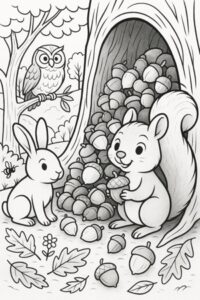
Question More, Action Knowledge.
Remember, at QMAK, we don’t just teach; we empower. We don’t just inform; we inspire. We don’t just question; we act. Become a Gold Member, and let’s unlock your child’s full potential, one question at a time.
Here you will find the resources that compliment the lessons taught during the month.
Songs are a great way to reinforce lessons in a fun, memorable way—by engaging musical and auditory learning styles, they help key ideas stick in children’s minds and support long-term retention well beyond the lesson.
Verse 1:
Like a squirrel gathering nuts
Or lakes that hold the rainfall’s touch
Every system needs its store
Saving up for something more
Pre-Chorus:
Physical things upon a shelf
Energy that can’t be felt
Balance what we save and spend
Resources we might need again
Chorus:
What We Keep, safe and sound
Like treasures buried underground
Not too much and not too few
What We Keep will see us through
Verse 2:
Knowledge stored within the mind
Waiting lines of patient time
Buffer zones for rainy days
Stock that keeps the system safe
(Pre-Chorus)
(Chorus)
Bridge:
Between the flow of out and in
Lives wisdom in what we maintain
Too much weighs the system down
Too little leaves us wanting now
(Chorus)
Outro:
What We Keep, now we know
How to help our systems grow
Having your child complete this coloring page right after reading the story helps transition the lesson from imaginative reading to creative expression, turning their thoughts into a vibrant work of art.
Color-In Picture

Movies are a great tool for engaging visual and auditory learners, and when paired with comprehension quizzes, they encourage active viewing—helping children process and retain key concepts rather than just being passively entertained.
Toy Story offers a delightful exploration of stock through Andy’s toy collection, where each toy represents a resource within an interconnected system.
Through Woody’s crisis when Buzz Lightyear arrives, students witness how changes in stock – whether additions or potential losses – can dramatically impact system dynamics.
The film cleverly demonstrates stock management through the toys’ shifting roles and values, from Woody’s status as a cherished resource suddenly threatened with obsolescence to the integration of new “stock” in the form of Buzz.
As viewers follow the toys’ adventures, they learn how stocks must be maintained and adapted to remain valuable within a system, illustrated by the toys’ constant efforts to stay relevant in Andy’s world.
Through this animated lens, students gain an accessible framework for understanding how resources accumulate, deplete, and influence the behavior of complex systems, whether those systems are toy collections or real-world resource networks.
1. How does Andy’s toy collection demonstrate the basic concept of stock?
a) It shows resources he has gathered over time
b) It only includes new toys
c) It represents temporary items
d) It shows random objects
2. Which type of stock do Woody and Buzz represent in Andy’s room?
a) Non-physical stock
b) Digital stock
c) Physical stock
d) Temporary stock
3. How does Andy’s toy box function in terms of stock management?
a) It destroys the toys
b) It serves as a storage system for his toy stock
c) It removes stock automatically
d) It creates new toys
4. What kind of stock system is demonstrated in Sid’s room?
a) A well-organized system
b) A non-physical system
c) A poorly managed physical stock system
d) A digital system
5. How do the toys in Andy’s room demonstrate stock rotation?
a) They get played with at different times and frequencies
b) They never change positions
c) They only get used once
d) They disappear after use
6. What happens to the “stock level” in Andy’s room when he receives new toys for his birthday?
a) Stock remains the same
b) Stock decreases
c) Stock disappears
d) Stock increases
7. How do the older toys demonstrate the concept of stock maintenance?
a) They require no care
b) They break down immediately
c) They maintain themselves
d) They need care to remain usable
8. What type of stock buffer is shown when Andy keeps extra toys in his toy chest?
a) No buffer at all
b) A reserve of toys for future play
c) A temporary system
d) A digital buffer
9. In terms of stock management, what does the toy chest represent?
a) A stock monitoring system
b) A destruction system
c) A storage system
d) A creation system
10. How does the movie show the importance of protecting stock?
a) The toys are indestructible
b) The toys maintain themselves
c) The toys need to be kept safe and in good condition
d) The toys never need protection
1. a
2. c
3. b
4. c
5. a
6. d
7. d
8. b
9. c
10. c
This beautifully illustrated book tells the story of a little monster who experiences a mix of emotions and learns to sort them out with the help of a friend. Each emotion is represented by a different color, and the monster discovers how to understand and express his feelings in a healthy way.
By engaging with this charming and insightful story, children can learn to identify and navigate their own emotions, and develop a greater appreciation for the power of art and creativity in self-expression.
1. What is the main character of the book?
a) A rainbow
b) A color monster
c) A paintbrush
d) A little girl
2. At the beginning of the story, how does the Color Monster feel?
a) Happy
b) Sad
c) Confused and mixed up
d) Angry
3. What does the little girl suggest to help the Color Monster?
a) Painting a picture
b) Taking a nap
c) Sorting his emotions into jars
d) Eating ice cream
4. What color represents happiness in the book?
a) Blue
b) Red
c) Yellow
d) Green
5. Which emotion is associated with the color red?
a) Sadness
b) Anger
c) Fear
d) Calm
6. What color represents sadness?
a) Blue
b) Green
c) Black
d) Purple
7. Which emotion is represented by the color black?
a) Love
b) Happiness
c) Fear
d) Calm
8. What color is associated with calmness?
a) Red
b) Yellow
c) Green
d) Pink
9. Which new emotion does the Color Monster discover at the end of the book?
a) Excitement
b) Love
c) Jealousy
d) Surprise
10. What is the main lesson of the book?
a) Colors are fun to mix
b) Monsters are always scary
c) It’s important to identify and understand emotions
d) Emotions should be kept in jars
1. b) A color monster
2. c) Confused and mixed up
3. c) Sorting his emotions into jars
4. c) Yellow
5. b) Anger
6. a) Blue
7. c) Fear
8. c) Green
9. b) Love
10. c) It’s important to identify and understand emotions
Setting “The Emotion Artist” exercise to music creates a powerful tool that helps children translate their abstract emotional experiences into tangible expressions through the combined languages of melody, rhythm, and imagery. A song about emotional exploration provides children with a memorable framework that normalizes feeling all emotions and transforms the potentially intimidating process of emotional identification into a playful, creative adventure. The musical format creates an immediate emotional resonance that helps children internalize healthy emotional processing techniques, giving them a comforting, accessible reference point they can return to whenever complex feelings arise, ultimately fostering emotional intelligence that will serve them throughout their lives.
Verse 1:
Close your eyes and take a peek
At the feelings you don’t always speak
Where in your body do they live?
What colors do your emotions give?
Pre-Chorus:
Is it round or square, rough or smooth?
Let your inner artist move
Chorus:
We’re Emotion Artists, painting how we feel
With colors bright and shapes so real
Brush strokes of joy, splashes of fear
Our canvas shows what we hold dear
Verse 2:
Maybe anger’s red and spiky
Happiness is yellow and smiley
Sadness might be blue and flowing
Excitement’s fireworks, always glowing
(Pre-Chorus)
(Chorus)
Bridge:
Let your feelings hold the brush
Or paint them with a gentle touch
There’s no right or wrong, just create
Your emotion’s art, it’s gonna be great
(Chorus)
Outro:
Open your eyes and what do you see?
A masterpiece of how you can be
Emotion Artists, that’s who we are
Painting feelings near and far

Remember, at QMAK, we don’t just teach; we empower. We don’t just inform; we inspire. We don’t just question; we act. Become a Gold Member, and let’s unlock your child’s full potential, one question at a time.